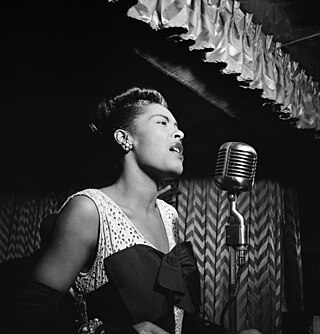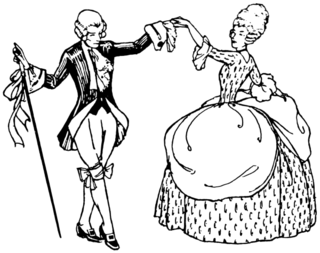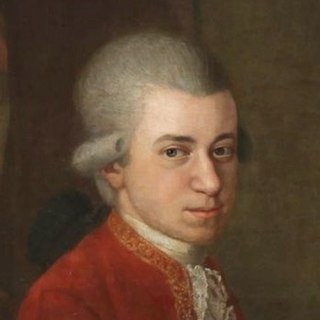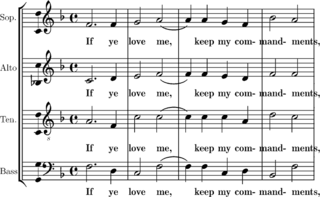
A song is a musical composition performed by the human voice. The voice often carries the melody using patterns of sound and silence. Songs have a structure to them, such as the common ABA form, and are usually made of sections that are repeated or performed with variation later. A song without instruments is said to be a cappella.

A minuet is a social dance of French origin for two people, usually in 3
4 time. The English word was adapted from the Italian minuetto and the French menuet.

American march music is march music written and/or performed in the United States. Its origins are those of European composers borrowing from the military music of the Ottoman Empire in place there from the 16th century. The American genre developed after the British model during the colonial and Revolutionary periods, then later as military ceremonials and for civilian entertainment events.
A scherzo, in western classical music, is a short composition – sometimes a movement from a larger work such as a symphony or a sonata. The precise definition has varied over the years, but scherzo often refers to a movement that replaces the minuet as the third movement in a four-movement work, such as a symphony, sonata, or string quartet. The term can also refer to a fast-moving humorous composition that may or may not be part of a larger work.
Ternary form, sometimes called song form, is a three-part musical form consisting of an opening section (A), a following section (B) and then a repetition of the first section (A). It is usually schematized as A–B–A. Prominent examples include the da capo aria "The trumpet shall sound" from Handel's Messiah, Chopin's Prelude in D-Flat Major "Raindrop", and the opening chorus of Bach's St John Passion.
In music, form refers to the structure of a musical composition or performance. In his book, Worlds of Music, Jeff Todd Titon suggests that a number of organizational elements may determine the formal structure of a piece of music, such as "the arrangement of musical units of rhythm, melody, and/or harmony that show repetition or variation, the arrangement of the instruments, or the way a symphonic piece is orchestrated", among other factors. It is, "the ways in which a composition is shaped to create a meaningful musical experience for the listener."
"Form refers to the largest shape of the composition. Form in music is the result of the interaction of the four structural elements described above [sound, harmony, melody, rhythm]."

Accompaniment is the musical part which provides the rhythmic and/or harmonic support for the melody or main themes of a song or instrumental piece. There are many different styles and types of accompaniment in different genres and styles of music. In homophonic music, the main accompaniment approach used in popular music, a clear vocal melody is supported by subordinate chords. In popular music and traditional music, the accompaniment parts typically provide the "beat" for the music and outline the chord progression of the song or instrumental piece.

The quickstep is a light-hearted dance of the standard ballroom dances. The movement of the dance is fast and powerfully flowing and sprinkled with syncopations. The upbeat melodies that quickstep is danced to make it suitable for both formal and informal events. Its origins are in combination of slow foxtrot combined with the Charleston, a dance which was one of the precursors to what today is called swing dancing.

Symphony No. 35 in D major, K. 385, also known as the Haffner Symphony, was composed by Wolfgang Amadeus Mozart in 1782. It was commissioned by the Haffners, a prominent Salzburg family, for the occasion of the ennoblement of Sigmund Haffner the Younger. The Haffner Symphony should not be confused with the eight-movement Haffner Serenade, another piece Mozart wrote on commission from the same family in 1776.
In music, instrumentation is the particular combination of musical instruments employed in a composition, and the properties of those instruments individually. Instrumentation is sometimes used as a synonym for orchestration. This juxtaposition of the two terms was first made in 1843 by Hector Berlioz in his Grand traité d'instrumentation et d'orchestration modernes, and various attempts have since been made to differentiate them. Instrumentation is a more general term referring to an orchestrator's, composer's or arranger's selection of instruments in varying combinations, or even a choice made by the performers for a particular performance, as opposed to the narrower sense of orchestration, which is the act of scoring for orchestra a work originally written for a solo instrument or smaller group of instruments.

In music, homophony is a texture in which a primary part is supported by one or more additional strands that provide the harmony. One melody predominates while the other parts play either single notes or an elaborate accompaniment. This differentiation of roles contrasts with equal-voice polyphony and monophony. Historically, homophony and its differentiated roles for parts emerged in tandem with tonality, which gave distinct harmonic functions to the soprano, bass and inner voices.
English Folk Song Suite is one of English composer Ralph Vaughan Williams' most famous works. It was first published for the military band as Folk Song Suite and its premiere was given at Kneller Hall on 4 July 1923, conducted by Lt Hector Adkins. The piece was then arranged for full orchestra in 1924 by Vaughan Williams' student Gordon Jacob and published as English Folk Song Suite. The piece was later arranged for British-style brass band in 1956 by Frank Wright and published as English Folk Songs Suite. All three versions were published by Boosey & Hawkes; note the use of three different titles for the three different versions. The suite uses the melodies of nine English folk songs, six of which were drawn from the collection made by Vaughan Williams’ friend and colleague Cecil Sharp.

In music, a trio is any of the following:
The Second Suite in F for Military Band is Gustav Holst's second of his two suites for concert band. Although performed less frequently than the First Suite in E♭, it is still a staple of the band repertoire. The Second Suite, written in 1911 and first published in 1922, dedicated to James Causley Windram, is longer and considered more difficult to play than its sister suite.

The kujawiak is a Polish folk dance from the region of Kujawy in central Poland. It is one of the five national dances of Poland, the others being the krakowiak, mazur, oberek, and polonaise.

The Piano Quartet No. 3 in C minor, Op. 60, completed by Johannes Brahms in 1875, is scored for piano, violin, viola and cello. It is sometimes called the Werther Quartet after Goethe's The Sorrows of Young Werther. The premiere took place in Vienna on November 18, 1875, to an anxious public. Richard Wagner and his wife Cosima were in attendance.

Baroque music refers to the period or dominant style of Western classical music composed from about 1600 to 1750. The Baroque style followed the Renaissance period, and was followed in turn by the Classical period after a short transition. The Baroque period is divided into three major phases: early, middle, and late. Overlapping in time, they are conventionally dated from 1580 to 1650, from 1630 to 1700, and from 1680 to 1750. Baroque music forms a major portion of the "classical music" canon, and is widely studied, performed, and listened to. The term "baroque" comes from the Portuguese word barroco, meaning "misshapen pearl". The works of George Frideric Handel and Johann Sebastian Bach are considered the pinnacle of the Baroque period. Other key composers of the Baroque era include Claudio Monteverdi, Domenico Scarlatti, Alessandro Scarlatti, Alessandro Stradella, Tomaso Albinoni, Johann Pachelbel, Henry Purcell, Antonio Vivaldi, Georg Philipp Telemann, Jean-Baptiste Lully, Jean-Philippe Rameau, Marc-Antoine Charpentier, Arcangelo Corelli, François Couperin, Johann Hermann Schein, Heinrich Schütz, Samuel Scheidt, Dieterich Buxtehude, Gaspar Sanz, José de Nebra, Antonio Soler, Carlos Seixas and others.
The Boston Brigade Band was a brass and reed band that performed in Boston, Massachusetts, and elsewhere in New England. Some of the musical pieces played by the band were subsequently published as sheet music, including "The Mammoth Cod Quickstep" of 1839. The band received acclaim in its day, particularly for its combination of both brass and woodwind instruments.

The Impromptus, Op. 90, D. 899, are a set of four impromptus for solo piano composed by Franz Schubert in 1827. They were written in the same year as the Impromptus, Op. 142, though only the first two pieces were published during Schubert's lifetime. Together with the latter set, they have become a cornerstone of the piano repertoire.













